The NAS’s Error Regarding the Origin of Life
There is no doubt that the first question the theory of evolution, which claims to explain the origin of life, has to answer is how life in an inanimate universe began and how inanimate materials came to produce living ones. Yet for some reason, the National Academy of Sciences' booklet Science and Creationism, prepared with the aim of putting forward "the most important proofs of the theory of evolution," contains no answer to that question. Instead, it contains the NAS authors' assumptions, which portray the theory of evolution as if it were something unquestioned and definitively proved, with no room for doubt, and which paint a "rosy picture" for evolutionists. This is what the authors have to say, as though the question of how it is that inanimate matter gave rise to living things as a result of chance chemical processes were not one of the greatest dilemmas facing the theory of evolution:
For those who are studying the origin of life, the question is no longer whether life could have originated by chemical processes involving nonbiological components. The question instead has become which of many pathways might have been followed to produce the first cells. (Science and Creationism, p. 6)
This is how the authors refer to the probability of the "chemical process" in question:
Experiments conducted under conditions intended to resemble those present on the primitive Earth have resulted in the production of some of the chemical components of proteins, DNA, and RNA. Some of these molecules also have been detected in meteorites from outer space and in interstellar space by astronomers using radio telescopes. Scientists have concluded that the "building blocks of life" could have been available early in Earth's history. (Science and Creationism, p.5)
In essence, what the NAS authors and evolutionists are claiming is this: In the environment of the inanimate world, commonly known as the "primeval soup," all the materials necessary for life to emerge existed, and these coincidentally came together by means of chemical processes to create the first living cell.
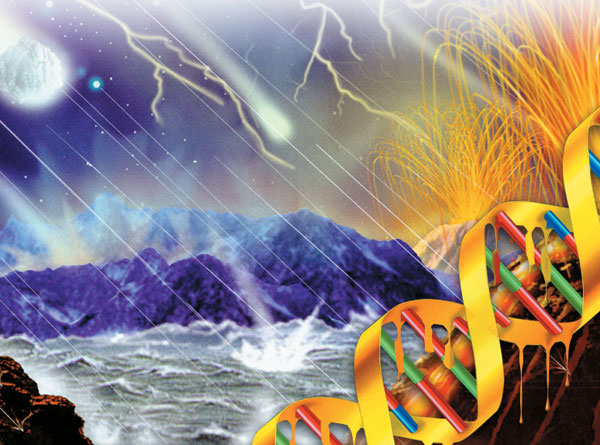
The conditions in the earliest periods of the Earth are among the most important factors making it impossible for the cell and its building blocks to have emerged by themselves. Laboratory experiments imitating these conditions have always ended in failure.
Although the NAS in particular does not actually spell it out, not one piece of evidence exists to back up this claim. In fact, the evidence all goes to invalidate the evolutionists' claims. Furthermore, experts on the subject, including evolutionists, decline to use such a confident and certain manner of speaking as the NAS writers, and accept that the subject of the origin of life is an unknown as far as the theory of evolution goes. Just the realization that the primeval Earth's atmosphere contained sufficient quantities of oxygen to tear apart any organic molecules (the establishment of the fact that it was not "reducing" as chemists put it) places the theory of evolution in a most difficult position as regards the origin of life. Noam Lahav, for instance, the evolutionist author of the book Biogenesis: Theories of Life's Origins, says:
[B]y challenging the assumption of a reducing atmosphere, we challenge the very existence of the "pre-biotic soup", with its richness of biologically important organic compounds. Moreover, so far, no geochemical evidence for the existence of a pre-biotic soup has been published. Indeed, a number of scientists have challenged the pre-biotic soup concept, noting that even if it existed, the concentration of organic building blocks in it would have been too small to be meaningful for pre-biotic evolution.1
In other words:
The high level of oxygen in the primeval atmosphere is an obstacle to the emergence of "the building blocks of life."
Even if it is assumed that these did emerge, it is impossible for them to have given rise to proteins, RNA or DNA by means of chemical reactions or chance. That is because proteins, RNA or DNA contain the most concentrated amounts of information and it is statistically impossible for that information to emerge at random.
Careful attention reveals that the NAS authors ignore both facts, and attempt to gloss over the second in particular by employing a style that gives them away: many people hearing the words "the building blocks of life" might well think that "these building blocks exist, which means that life can emerge by itself." (This is the impression the NAS authors hoped to create.) This is mistaken, however, and also deceptive (from the NAS' point of view), because the "building blocks" in question are simple organic compounds such as amino-acids or nucleic acids, and it is impossible for these to turn into such complex structures as RNA or DNA. In just the same way, the existence of bricks, the "building blocks" of a house, does not mean that these actually came together by chance to make a house.
The NAS claims that many paths are known which might have been followed to create the first cell. That claim is most definitely incorrect. No scientist has found any means by which the first cell could have been created from inanimate matter. Professor Klaus Dose, director of the Johannes Gutenberg University Biochemistry Institute, expresses the problem in these terms:

The presence of all the materials necessary for the construction of a house is not enough for that construction to actually take place. There is also a need for rational and intelligent architects, construction engineers, technicians, laborers, etc. The same thing applies to the construction of the cell.
More than 30 years of experimentation on the origin of life in the fields of chemical and molecular evolution have led to a better perception of the immensity of the problem of the origin of life on earth rather than to its solution. At present all discussions on principal theories and experiments in the field either end in stalemate or in a confession of ignorance. New lines of thinking and experimentation must be tried… Considerable disagreements between scientists have arisen about detailed evolutionary steps. The problem is that the principal evolutionary processes from prebiotic molecules to progenotes [the earliest genetic organisms] have not been proven by experimentation and that the environmental conditions under which these processes occurred are not known. Moreover, we do not actually know where the genetic information of all living cells originates, how the first replicable polynucleotides (nucleic acids) evolved, or how the extremely complex structure-function relationships in modern cells came into existence... It appears that the field has now reached a stage of stalemate, a stage in which hypothetical arguments often dominate over facts based on experimentation or observation.2
The evolutionist biologist Andrew Scott makes a similar admission, saying:
Take some matter, heat while stirring and wait. That is the modern version of Genesis. The 'fundamental' forces of gravity, electromagnetism and the strong and weak nuclear forces are presumed to have done the rest... But how much of this neat tale is firmly established, and how much remains hopeful speculation? In truth, the mechanism of almost every major step, from chemical precursors up to the first recognizable cells, is the subject of either controversy or complete bewilderment.3
David A. Kaufman, a professor of biochemistry, admits that the theory of evolution cannot account for the origin of genetic life in these terms:
Evolution lacks a scientifically acceptable explanation of the source of the precisely planned codes within cells without which there can be no specific proteins and hence, no life.4
Instead of admitting that the theory of evolution offers no explanation however, the NAS authors prefer to resort to deception by painting an unrealistic picture in its favor. They put forward the groundless claim that there is proof of evolution in all areas and that they possess several hypotheses accounting for the origin of life, which is something that no expert on the subject could possibly confirm. This rosy picture painted by evolutionists very definitely fails to reflect the true state of affairs. Each one of the hypotheses regarding the origin of life is in the same quandary, and these alternatives all fail to resolve the problem; they all merely pose the question in a different form. One of these so-called alternatives in the Science and Creationism is the "RNA World" hypothesis. Despite being at present one of the most popular hypotheses amongst evolutionists, the RNA World theory actually contains a great many difficulties, as we shall be seeing, and is clearly a scenario which could never have taken place.
The RNA World Scenario
In the book Science and Creationism, the RNA World hypothesis is suggested as one of the alternative (and reasonable) explanations of the origin of life. However, the RNA World hypothesis is at a loss to account for the origin of life just like all the explanations put forth by evolutionists.
The discovery in the 1970s that the gases originally existing in the primeval Earth's atmosphere would have rendered amino-acid synthesis impossible was a serious blow to the theory of molecular evolution. Evolutionists then had to face the fact that the "primitive atmosphere experiments" by Stanley Miller, Sydney Fox, Cyril Ponnamperuma, and others were invalid. For this reason, in the 1980s the evolutionists tried again. As a result, the RNAWorld hypothesis was advanced. This scenario proposed that, not proteins, but rather the RNA molecules that contained the information for proteins, were formed first.
According to this scenario, advanced by Harvard chemist Walter Gilbert in 1986, inspired by the discovery of "ribozymes" by Thomas Cech, billions of years ago an RNA molecule somehow capable of replicating itself happened to come into existence. Under the influence of the environmental conditions surrounding it, this RNA molecule suddenly began to produce proteins. Later still, the need arose to store their information in a second molecule, and the DNA molecule somehow came into being.

Like the evolutionists' other scenarios, the RNAWorld hypothesis is a long way from bringing an evolutionary explanation to bear on the origin of life. Unable to explain how DNA could have come into being on its own, evolutionists face the same question with regard to RNA.
This scenario, which is hard even to imagine and which consists of a chain of impossible events, enlarged the dimension of the problem instead of explaining the origin of life, and gave rise to a number of unanswerable questions. Some of these questions are:
1 – Whilst it is impossible to account for the emergence of even a single one of the nucleotides which comprise RNA, how did fictitious nucleotides manage to come together in an appropriate sequence to form RNA? The evolutionist biologist John Horgan admits the impossibility of RNA's having come into existence by chance:
As researchers continue to examine the RNA-World concept closely, more problems emerge. How did RNA initially arise? RNA and its components are difficult to synthesize in a laboratory under the best of conditions, much less under really plausible ones.5
2 – Even if we assume that it did come into existence by chance, with what consciousness did this RNA molecule consisting solely of a string of nucleotides decide to replicate itself, and by what mechanism did it succeed in doing so? Where did it find the nucleotides it would use while replicating itself? The evolutionist microbiologists Gerald Joyce and Leslie Orgel express the hopelessness of the position in these terms:
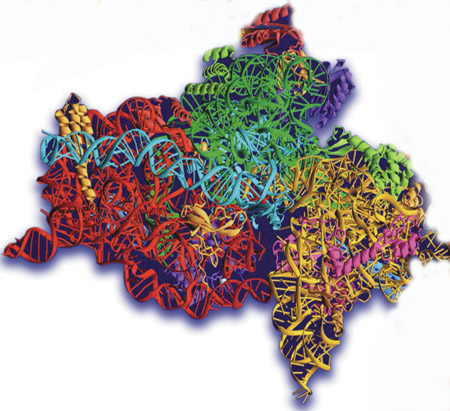
According to the RNA World hypothesis, ribosomes need to form at the same time as RNA, because RNA requires ribosomes, a protein-manufacturing mechanism. However, ribosomes are exceedingly complex organelles consisting of complex proteins. It is impossible to account for the origin of ribosomes in terms of chemical reactions.
This discussion… has, in a sense, focused on a straw man: the myth of a self-replicating RNA molecule that arose de novo from a soup of random polynucleotides. Not only is such a notion unrealistic in light of our current understanding of prebiotic chemistry, but it would strain the credulity of even an optimist's view of RNA's catalytic potential.6
3 – Even if we go so far as to accept that RNA capable of replicating itself did emerge in the primeval Earth's atmosphere and that every kind of amino acid the RNA would use was present in unlimited quantities and that all these impossibilities in some way happened, that still is not sufficient for the emergence of a single protein molecule. That is because RNA is nothing but information insofar as protein structure is concerned. Amino acids are the raw material. Yet there is no "mechanism" here that might produce the protein. Considering the existence of RNA as sufficient for the production of protein is just as meaningless as expecting the thousands of parts that would go to make up a car to congregate on the blueprint of that car and for the vehicle to assemble itself.
A protein is produced at the end of exceedingly complicated processes within the cell inside an organelle known as the ribosome, together with the help of a large number of enzymes. The ribosome is a complicated cell structure consisting of RNA and proteins. For that reason, this situation involves a series of impossible assumptions, such as the ribosome's coincidentally coming into existence at the same time. Even the Nobel prize-winning Jacques Monod, one of the best-known proponents of the theory of evolution, explained that protein synthesis can by no means be considered to depend merely on the information in the nucleic acids:
The code is meaningless unless translated. The modern cell's translating machinery consists of at least 50 macromolecular components, which are themselves coded in DNA: the code cannot be translated otherwise than by products of translation themselves. It is the modern expression of omne vivum ex ovo. When and how did this circle become closed? It is exceedingly difficult to imagine.7
By what means could an RNA chain in the primitive atmosphere have taken such a decision, and what methods could it have employed to carry out protein production and perform the functions of 50 special components? Evolutionists have no answer to this question. One article in the well-known scientific journal Nature stated that the concept of "self-replicating RNA" was a totally imaginary one, and that no such RNA had ever been produced under experimental conditions:
DNA replication is so error-prone that it needs the prior existence of protein enzymes to improve the copying fidelity of a gene-size piece of DNA. "Catch-22" say Maynard Smith and Szathmary. So, wheel on RNA with its now recognized properties of carrying both informational and enzymatic activity, leading the authors to state: "In essence, the first RNA molecules did not need a protein polymerase to replicate them; they replicated themselves." Is this a fact or a hope? I would have thought it relevant to point out for 'biologists in general' that not one self-replicating RNA has emerged to date from quadrillions (1024) of artificially synthesized, random RNA sequences. 8
Stanley Miller, a professor at the University of California—San Diego, and the well-known evolutionist Leslie Orgel, a colleague of Francis Crick, use the term "scenario" for the possibility that "life might have begun with the RNA World." In an article called "The Origin of Life on the Earth," published in Scientific American in its October 1994 edition, Orgel set out the features that RNA would need to possess and the impossibility of its doing so:
This scenario could have occurred, we noted, if prebiotic RNA had two properties not evident today: a capacity to replicate without the help of proteins and an ability to catalyze every step of protein synthesis.9
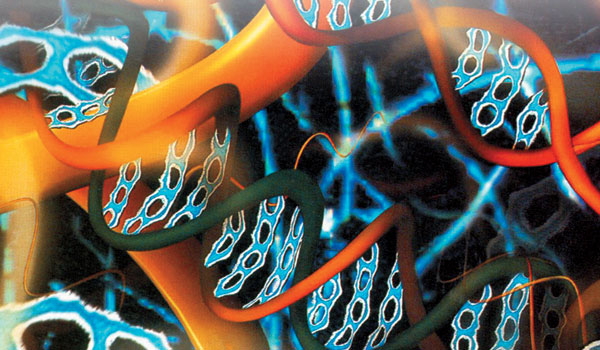
It can clearly be seen that expecting Orgel's precondition of these two complex processes from a molecule such as RNA is a violation of scientific thinking. Concrete scientific facts reveal that the "RNA World" thesis, a new version of the claim that life emerged by chance, is a scenario which could never have happened.
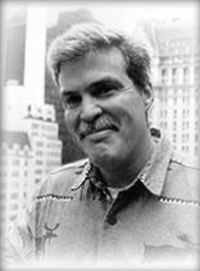
John Horgan
In his book The End of Science, John Horgan describes a conversation with Stanley Miller, who gave his name to the famous Miller experiment which subsequently proved to be invalid. Miller said that he found the latest theories put forward regarding the origin of life to be meaningless, and rather despised them:
In fact, almost 40 years after his original experiment, Miller told me that solving the riddle of the origin of life had turned out to be more difficult than he or anyone else had envisioned… Miller seemed unimpressed with any of the current proposals on the origin of life, referring to them as "nonsense" or "paper chemistry." He was so contemptuous of some hypotheses that, when I asked his opinion of them, he merely shook his head, sighed deeply, and snickered-as if overcome by the folly of humanity. Stuart Kauffman's theory of autocatalysis fell into this category. "Running equations through a computer does not constitute an experiment," Miller sniffed. Miller acknowledged that scientists may never know precisely where and when life emerged.10
Even the fiercest proponents of evolution, such as Miller, who led the effort to discover an evolutionary explanation for the origin of life, make statements of despair as far as the theory of evolution goes, and thus clearly reflect the enormous difficulties in which the theory finds itself.
The Nas’s Cell From Mars Error
It is also suggested in the booklet Science and Creationism that the first cells might have come to earth from Mars. (Science and Creationism p. 7)
Mars is a refuge for evolutionists who are unable to explain how the first cell might have come into being by chance in the conditions of the primeval world. However, a theory which cannot explain how the first cell came into existence on Earth will encounter just the same difficulty on Mars. Indeed, a great many difficulties and obstacles will face a cell assumed to have emerged on Mars in the course of its journey to the Earth, which makes the claim that this first cell emerged on Mars quite untenable. The well-known physicist George Gamow states how any cell on such a "space voyage" would inevitably die:
It must be borne in mind, however, that such travelling spores would be threatened by another agent much more perilous than the danger of "freezing to death." It is now known that the ultraviolet rays of the Sun, which are almost entirely absorbed by the terrestrial atmosphere, will rapidly kill any micro-organism that ventures beyond this protective shield. Thus, life must be inevitably extinguished in such travelling spores long before they are able to reach even the nearest planet. Besides, quite apart from the problem of the preservation of life during the long interstellar voyage, the "cosmozoan hypothesis" becomes rather senseless in the light of modern knowledge concerning the age and origin of the stellar universe.11
Professor Gamow's words are very clear, and the experiment shows that even if a cell did somehow emerge on Mars, it would be impossible for it to reach the Earth.
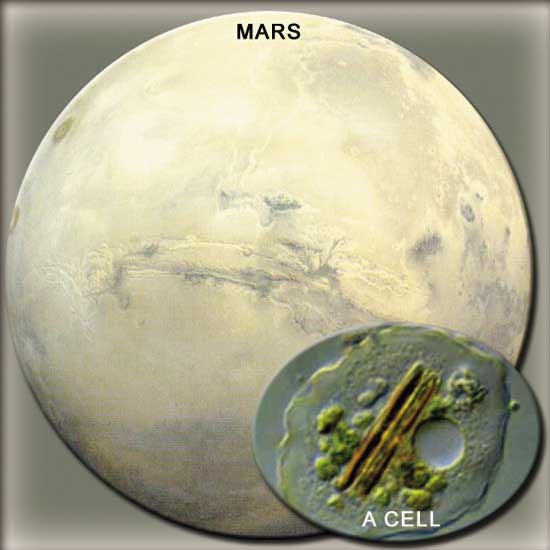
Evolutionists are unable to explain how the first cell could have formed in the conditions of the primitive Earth. One of the places evolutionists seek refuge is Mars. However, what is impossible on Earth is also impossible on Mars.
Here, what evolutionists ignore is the complexity of the cell structure. They attempt to give the impression that the only difficulty regarding the emergence of the first cell is the conditions on the Earth. As a result, they claim that if those conditions on Earth were unsuitable, the first cell must have formed on Mars. The fact is, however, that the point which really makes it impossible for the first cell to have come into existence by itself, under random conditions, is the complex structure and superior organization possessed by the cell.
The cell comprises a great many different organelles, each with its own very complex structure. For instance, the cell membrane permits certain compounds to enter the cell and keeps others out. It recognizes substances harmful to the cell and refuses to admit them. The nucleic acids in the cell (DNA and RNA) contain all the information about the organism. The amount of information contained in these structures can be compared to that in a whole library. The cell also contains protein-producing ribosomes. These use hundreds of amino acids to produce protein. Each separate part is of a wondrous complexity. None of these can exist on its own, and if even one is missing, the cell cannot form. For that reason, all the cell's components and organelles must have existed together from the very beginning. It is impossible, as the theory of evolution would have us believe, for these tiny components to have come together stage by stage over millions of years.
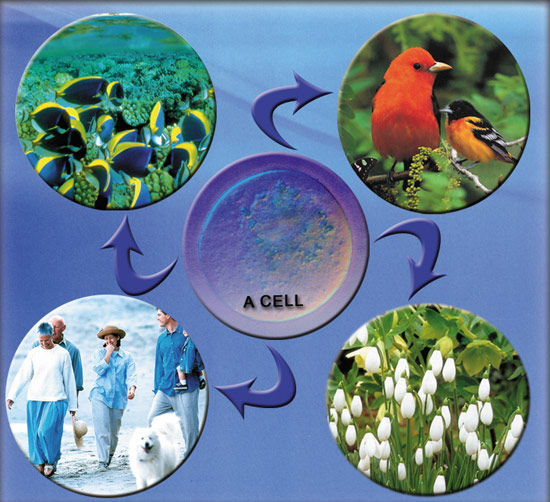
The theory of evolution is unable to explain how a cell turned into fish, birds, flowers, and human beings.
Fred Hoyle and Chandra Wickramasinghe, both professors of mathematics and astronomy, explain how there is no possibility that life could have come about on its own as the result of chance, either on the Earth or on another planet, in these terms:
The trouble is that there are about two thousand enzymes, and the chance of obtaining them all in a random trial is only one part in (1020)2,000 = 1040,000, an outrageously small probability that could not be faced even if the whole universe consisted of organic soup. If one is not prejudiced either by social beliefs or by a scientific training into the conviction that life originated on the Earth [by chance or natural processes], this simple calculation wipes the idea entirely out of court.
. . . Life cannot have had a random beginning. Troops of monkeys thundering away at random on typewriters could not produce the works of Shakespeare, for the practical reason that the whole observable universe is not large enough to contain the necessary monkey hordes, the necessary typewriters, and certainly the waste paper baskets required for the deposition of wrong attempts. The same is true for living material.12
As we have seen, what makes the emergence of the first cell impossible is not only the unsuitable conditions in the primeval atmosphere, but also the complex structure of the cell and the fact that that structure could not have come about by chance. There is thus no reason why something which is impossible on Earth should be able to take place on Mars. In the same way that it is impossible for random letters thrown onto the ground to make a meaningful phrase on Earth, so it is also impossible on Mars. Nobody can say "If we throw them onto the ground on Mars, a coherent phrase will emerge."

Unable to explain how the first cell could have come about by chance, and in order to deny God's creation, evolutionists suggest that the first cell was brought to Earth by creatures from space.
The Nobel prize-winning Professor Manfred Eigen states that the thesis that life came from space in no way resolves the difficulties facing the theory of evolution:
The discrepancy between the numbers of sequences testable in practice and imaginable in theory is so great that attempts at explanation by shifting the location of the origin of life from Earth to outer space do not offer an acceptable solution to the dilemma. The mass of the universe is 'only' 1029 times, and its volume 'only' 1057 times that of the Earth.13
Furthermore, a cell coming to the earth from space cannot solve the difficulties of the theory of evolution, since the theory is unable to explain how a single cell managed to turn into fish, birds, flowers and human beings.
Fred Hoyle and Chandra Wickramasinghe were among the most ardent supporters of the idea that life might have come from space (1981). Francis Crick (1981) and Leslie Orgel (1973) also proposed the idea of "panspermia" (the claim that amino acids in meteors from space reacted with organic substances, thus producing life). They even took the idea further, suggesting that life had been designed by living things in space and then sent to Earth. This is just as futile as claiming that amino acids or the first cell came to Earth via meteorites, since the question obviously remains of how the aliens who designed life themselves came into being.
What compels evolutionists to put forward these claims, for which there is no evidence and which have no other value than as fodder for science fiction films? The reason is that these people see that it is impossible for an evolutionary approach to account for the origin of life and are desperately seeking a materialist explanation at all costs. Just to avoid believing in the existence of God, these scientists have suffered such a collapse of logic as to be able to believe, without a shred of evidence, in the existence of space creatures—and are unable to see that the question of how these creatures came into existence will again leave them staring creation in the face.
1 George Gamow, Biography of the Earth, Viking Press, 1959, p. 156.
2 Sir Fred Hoyle-Chandra Wickramasinghe, Evolution from Space, New York: Simon and Schuster, 1984, p. 24, p. 148.
3 Manfred Eigen, Steps Toward Life, Oxford: Oxford University Pres, 1992, p. 11.
NOTES
1. Noam Lahav, Biogenesis: Theories of Life's Origins, Oxford University Press, 1999, pp. 138-139.
2. Klaus Dose, "The Origin Of Life: More Questions Than Answers", Interdisciplinary Science Reviews, vol. 13, no.4, 1988, p. 348. 
3. Andrew Scott, "Update on Genesis", New Scientist, vol. 106, May 2, 1985, p. 30. 
4. David B. Loughran, SBS Vital Topics, April 1996, Stewarton Bible School, Stewarton, Scotland; http://www.rmplc.co.uk/eduweb/sites/ sbs777/vital/evolutio.html 
5. John Horgan, "In the Beginning," Scientific American, vol. 264, February 1991, p. 119. 
6. G.F. Joyce, L. E. Orgel, "Prospects for Understanding the Origin of the RNA World," In the RNA World, New York: Cold Spring Harbor Laboratory Press, 1993, p. 13. 
7. Jacques Monod, Chance and Necessity, New York: 1971, p.143. (emphasis added) 
8. Gabby L. Dover, 1999, Looping the Evolutionary loop. Review of the origin of life from the birth of life to the origin of language, Nature, 399: 218. (emphasis added) 
9. Leslie E. Orgel, "The Origin of Life on the Earth," http://proxy.arts.uci.edu/~nideffer/ Hawking/early_proto/orgel.html
10.John Horgan, The End of Science, MA Addison-Wesley, 1996, p. 139.
11. George Gamow, Biography of the Earth, Viking Press, 1959, p. 156.
12. Sir Fred Hoyle-Chandra Wickramasinghe, Evolution from Space, New York: Simon and Schuster, 1984, p. 24, p. 148.
13. Manfred Eigen, Steps Toward Life, Oxford: Oxford University Pres, 1992, p. 11.
- Introduction
- The nas's error regarding the origin of life
- The nas's error on natural selection
- The nas's errors regarding mutations
- The nas's errors regarding speciation
- The nas's errors on the subject of the fossil record
- The nas's error in portraying common structures as evıdence of evolution
- The nas's error ın portraying the distribution of species as evidence of evolution
- The nas’s misconception about embryology
- The nas's error in portraying molecular biology as evidence of evolution
- The nas's human evolution error
- The nas's errors in the chapter on creationism and the evidence for evolution
- Creation ıs a scientific fact
- Conclusion
